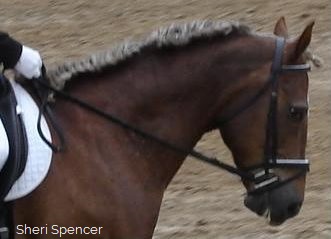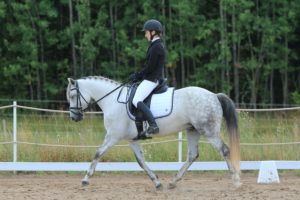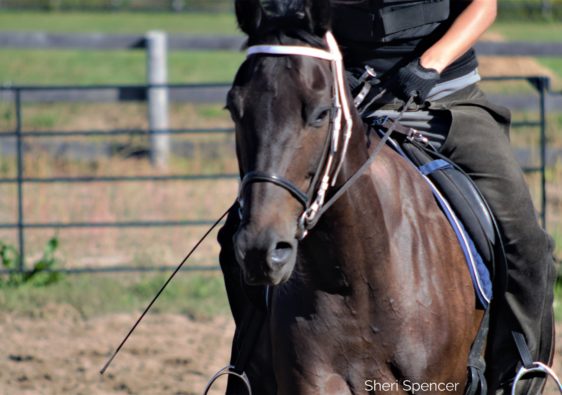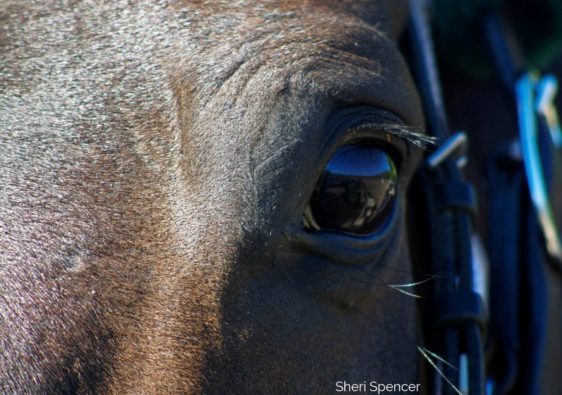First let me clarify that I will be discussing over-flexion and not looking at or critiquing rollkur, the latter being something worthy of a blog post all its own, but I digress. Over-flexion is occasionally a soft-mouthed horse’s method of evading the bit, or a developed habit from a heavy-handed rider. Despite the “aesthetics” of all of those beautiful upper-level dressage horses that are so round through the neck, it is indeed quite incorrect when their noses are consistently behind their eyes.
Here you will find:
- What is over-flexion? An assessment.
- Exercises to Accept Contact
- Exercises to Encourage Forward Reach
What is over-flexion?
To understand the subtlety of even mild over-flexion, it is easiest to first have a quick look at what it isn’t, and assess the “ideal” carriage.

In the dressage world, it is generally accepted that in any collected or working gait, the poll of the horse should be the highest point. Some leeway is granted for crests and musculature (particularly for baroque-style breeds), but it is a good rule of thumb as a guideline. (In “long and low”, technically the wither is, but such carriage should be in moderation as stretching/cooling out).
The profile of the horse (when viewed from the side), should be vertical, or deviated slightly in front of the vertical (ie: nose leading slightly).
 On a “long frame”, the centre of the neck may be higher than the poll, and should be a smooth even arch with, again, the face in vertical profile. (See the palomino, pictured right.)
On a “long frame”, the centre of the neck may be higher than the poll, and should be a smooth even arch with, again, the face in vertical profile. (See the palomino, pictured right.)

Over-flexion, therefore, is when the profile comes “behind the vertical” (in quotations as it, too, is a term of its own), and is demonstrated as the nose being tilted more towards the chest, with the forehead sloped slightly (to extremely) towards the ground. (See left.)
This carriage can be anywhere from very mild and discrete to severe, but to any degree is arguably a detriment to healthy carriage.
So whether you are looking to correct a developed habit from years of someone else’s riding, or encouraging a gentle acceptance of the bit for the horse who evades contact by “dipping behind” it, I’ll provide a few techniques to try in order to encourage your horse to reach more forward to accept the contact.
Accepting Contact
For the horse that chronically ducks behind the bit, once you have ruled out any dental issues (do have your horse’s teeth checked every year!), it is crucial that as you teach your horse to accept contact, you are simultaneously teaching your hands to “think” on their own and develop extra-sensitivity for feel.

One of the best ways to show a horse that a bit is “not out to hurt them” is actually by lunging them with side reins, as the side reins are perfectly consistent and only jerk the mouth when the horse jerks his head. They quickly figure this out and tend to settle in a position that is comfortable. To use them: adjust your side reins so that they can be comfortably and easily attached while your horse is standing in a relaxed, natural fashion (yes, with their noses out), and begin by leading them with the side reins to assess and be able to react to their reaction. For starting out, it is better to have too loose side reins than have them too tight! If the horse refuses to walk or starts backing up, take them off immediately and lengthen them a couple inches before trying again. (Be advised: if the side reins are too short, the horse may rear up trying to “escape” the contact.)
Under saddle, you can easily assess your horse’s willingness to “submit” to pressure by gently vibrating your inside rein while at the halt. Any give\ on the horse’s part indicates that they understand, and should immediately be rewarded by stopping the vibration and softening that hand. This teaches them to respond to the subtlest of pressures and that they will be rewarded for it. This is similarly a good practice to accustom a sensitive-mouthed horse to gentle pressure with the promise of a reward, a softened rein.
(I will go into further detail on this subject in another post, but these two practices are often enough to progress to the following exercises.)
Encourage Forward Reach
In order to reach and lengthen into contact, you want them reacting to it, a demonstration that they are acknowledging your hands. You can thus encourage you horse to lengthen his neck with a sequence of subtle cues. After you’ve warmed up, try the following:
On a large circle with a forward, working trot, ask for suppling to the inside, a slight bend or “give” to the hand, and as soon as they soften, either laterally or longitudinally, give through your elbow. If they stay connected with your hand when you put your elbow forward, let it slide forward a little more, let the reins slide through your hands if you have to, just enough to say “yes, stretch!” while maintaining a feel. But! If when you put your hands forward as a reward and they immediately lose connection, gently vibrate your inside rein (like you did at the halt), and reward with a giving elbow as soon as they soften. Even if they lift their heads again, just gently vibrate that inside rein and as soon as they soften again, stop and soften, then follow their heads as far down and forward as they are willing to go provided they are still supple to your hands. If they try to pull or stiffen against the hand, just gently vibrate that inside rein and reward the moment they soften.
As you do this, you should also be regulating the tempo with your seat, ensuring that they do not begin rushing, nor suck back and stumble back down into a walk. Punctuate the rhythm with your posting trot, and half-halt to balance, while utilizing that inside leg as needed to maintain your rhythm. (Who said riding was easy?)

Once you have the feel and mutual understanding of what it is you are asking for with your vibratos and your “give”, you can re-establish a shorter boundary.
Whether you accomplish this in one ride or three or ten, once you have them reaching into contact, you can determine how much rein to give to set the length of the neck, and even get back to your gathered “dressage frame” as long as you continue to consistently ask them to stretch forward into the contact, and consistently soften and give through your elbows to facilitate that. Even during your working and collected gaits, while your seat and legs address the gait and tempo, your hands are always to remain aware and using those same techniques as before to encourage the horse to reach into your hands.
This is not only gentler on the mouth of the horse, but facilitates his ability to see where he is going while also paving the way for freeing his shoulder and in turn making it possible for him to strengthen an “uphill” means of travel.
If you are uncertain or have questions about the advantages to the horse’s movement, I encourage you to read Creating Better Movement: A Look at the Shoulder and Neck, or Function of the Neck.
As always, I would love to hear your feedback or address any questions you may have.




[…] Over-flexion may not always be the result of a rider with hard hands. Some horses will put themselves into this position to avoid the bit. In these cases the horse had been trained aggressively by a past owner or is a horse who does not want contact with the bit (possibly sensitive mouth). (https://equicessities.wordpress.com/2014/11/23/how-to-correct-over-flexion-from-the-bit/) […]
[…] Over-flexion may not always be the result of a rider with hard hands. Some horses will put themselves into this position to avoid the bit. In these cases the horse had been trained aggressively by a past owner or is a horse who does not want contact with the bit (possibly sensitive mouth). (https://equicessities.wordpress.com/2014/11/23/how-to-correct-over-flexion-from-the-bit/) […]
Absolutely! 🙂
[…] Over-flexion may not always be the result of a rider with hard hands. Some horses will put themselves into this position to avoid the bit. In these cases the horse had been trained aggressively by a past owner or is a horse who does not want contact with the bit (possibly sensitive mouth). (https://equicessities.wordpress.com/2014/11/23/how-to-correct-over-flexion-from-the-bit/) […]